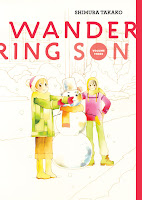 Creator: Takako Shimura
Creator: Takako Shimura
U.S. publisher: Fantagraphics Books
ISBN: 9781606996478
Released: September 2013
Original release: 2006
The fifth volume of Takako Shimura’s manga series Wandering Son was originally published in Japan in 2005 while the English-language edition of Wandering Son, Volume 5 was published by Fantagraphics in 2013. The entire series is being released in English as beautiful hardcovers; Fantagraphics’ treatment of the manga is simply lovely. Wandering Son is a series that has come to mean a tremendous amount to me on a very personal level. I am very grateful to Fantagraphics for pursuing the manga in English. Wandering Son is a wonderful story about growing up and personal identity with a very sincere and sensitive look at gender and sexuality. The series started out strong and it continues to be a powerful work. Although reading it can sometimes be traumatic for me because the story touches on issues that hit so close to home, I always look forward to reading the next volume of Wandering Son. I wish I didn’t have to wait for so long between volumes, but it’s always worth it.
With the beginning of seventh grade students are faced with a new school, new teacher, new classmates, and maybe even a few new crushes. In some ways junior high is a chance for a new start, but some problems are carried over from middle school. Shuichi’s close circle of friends has started to fall apart as romantic feelings get in the way and cause a fair amount of tension within the group. The rift between Takatsuki and Chiba has grown particularly wide. It seems as though the two of them may never be able to make up, despite the pain that their falling out has caused for the rest of their friends. Though they are still very close, things have become rather awkward between Shuichi and Takatsuki as well after Shuichi declared having feelings for Takatsuki and Takatsuki gently rejected them. Fortunately, Shuichi has Mako as a source of comfort and reason. It’s a good thing, too, as junior high and puberty have their own challenges; having someone to commiserate with is invaluable. Making new friends doesn’t hurt either, although sometimes that just complicates matters even further.
While the focus of Wandering Son, Volume 5 is still on Shuichi and Takatsuki and their families and friends, it’s interesting to see part of the manga being told from the perspective of their new teacher Manabu Saisho. It actually happens to be his first year teaching. He’s inexperienced and easily flustered, and his eagerness may end up getting him into trouble, but so far I (like Mako) find him charming. But as volatile as junior high and his students can be, I do worry for him a bit. And I worry for Shuichi and the others as well. Adolescence is upon them as are all the changes that entails, most of which cannot be ignored. Mortified after being publicly called out by the basketball coach, Takatsuki is faced with the embarrassing prospect of bra shopping while Shuichi and Mako are trying to come to terms with the fact that their voices will soon be changing. Even seemingly benign statements such as “they’ve grown taller again” are painfully bittersweet reminders of what is in store for them as they continue to physically mature.
Shimura does a fantastic job of layering the textual narrative of Wandering Son with its artwork. The manga’s composition is excellent. There is a particularly effective scene fairly early on in the fifth volume that takes place during the academic year’s opening ceremonies—the commencement speaker expresses the desire for everyone to talk together and encourage one another while the illustration clearly shows that Shuichi and the others can hardly bear to look at one another and that some of them aren’t even on speaking terms. Wandering Son is filled with deceptively simple moments like these in which the artwork and the text express far more together than they ever would alone. Wandering Son is told in such a way that it comes across as a sequence of closely related impressions or vignettes rather than a single, rigidly structured storyline. It’s quite effective in conveying the manga’s more emotive and introspective qualities. I continue to be impressed by Shimura’s work in Wandering Son and look forward to the next volume a great deal.




